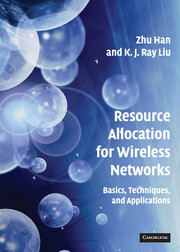Book contents
- Frontmatter
- Contents
- Preface
- 1 Introduction
- Part I Basics Principles
- Part II Optimization Techniques for Resource Allocation
- Part III Advanced Topics
- 10 Resource Allocation with Antenna-Array Processing
- 11 Dynamic Resource Allocation
- 12 Resource Allocation for Cooperative Networks
- 13 Game-Theoretic Approaches for Resource Allocation
- 14 Ad Hoc/Sensor/Personal-Area Networks
- 15 Resource Allocation for Wireless Multimedia
- Bibliography
- Index
14 - Ad Hoc/Sensor/Personal-Area Networks
from Part III - Advanced Topics
Published online by Cambridge University Press: 05 August 2012
- Frontmatter
- Contents
- Preface
- 1 Introduction
- Part I Basics Principles
- Part II Optimization Techniques for Resource Allocation
- Part III Advanced Topics
- 10 Resource Allocation with Antenna-Array Processing
- 11 Dynamic Resource Allocation
- 12 Resource Allocation for Cooperative Networks
- 13 Game-Theoretic Approaches for Resource Allocation
- 14 Ad Hoc/Sensor/Personal-Area Networks
- 15 Resource Allocation for Wireless Multimedia
- Bibliography
- Index
Summary
Introduction
Over the past few decades, increasing demands from military, national security, and commercial customers have been driving the large-scale deployment of ad hoc networks, sensor networks, and personal area networks. Unlike the cellular network or the WiMAX, there are no sophisticated infrastructures such as base stations for these wireless networks. In these scenarios, the mobile users have to set up the network functionality on their own. For example, an individual sensor can sense its immediate environment, process what it senses, communicate its results to others over a wireless link, and possibly take an action in response. Although a single sensor has very limited use, a network of sensors can be used to manage large environments and systems.
These types of wireless networks contain new types of computing machines, run different kinds of network applications, execute in different physical environments, and possess large numbers of nodes. Moreover, there are other challenges such as battery life, maximal power, interferences, limited bandwidth, and connectivity for the different applications of such networks. Significant scientific and technical progress is required to realize the potential of these networks. In short, building such networks requires overcoming many challenges, especially from an optimization design point of view. In this chapter, we study three examples for ad hoc networks, sensor networks, and ultrawide-band (UWB) networks, respectively.
- Type
- Chapter
- Information
- Resource Allocation for Wireless NetworksBasics, Techniques, and Applications, pp. 439 - 487Publisher: Cambridge University PressPrint publication year: 2008



